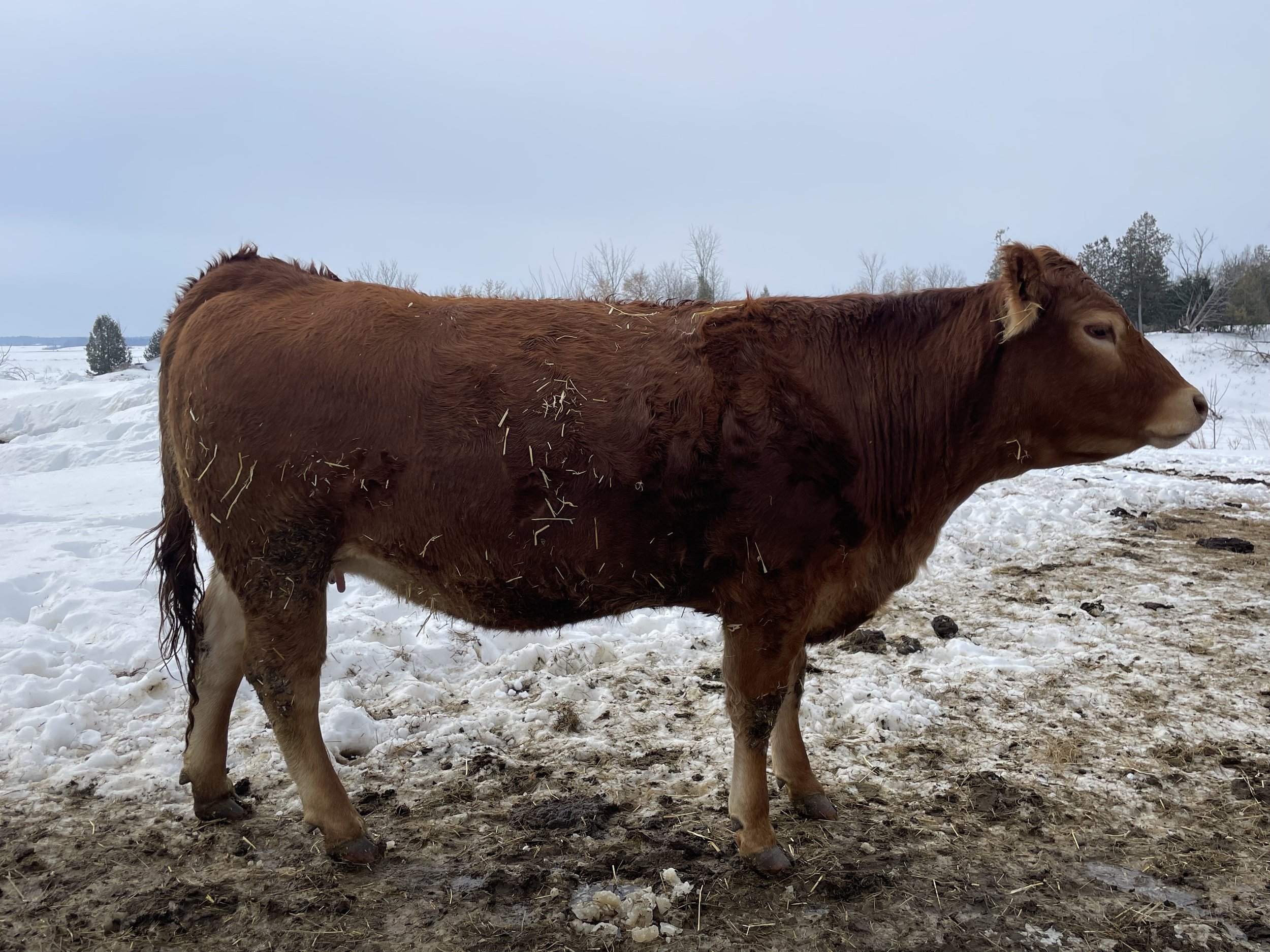The Fullblood Limousin
Back when I started raising beef, I was torn between two breeds. I had mixed-breed cattle, but I knew that long-term, I wanted to raise registered breeding stock. This meant I had to decide which breed to focus on. My family had raised Charolais for a few years after they got out of dairy, and the two cows I started my herd with were Charolais crosses from that herd. The other breed that caught my interest at the time was the Limousin. Within the original Charolais herd, there were also four Limousin cows. I fondly remember naming the largest of those four females “Baylene,” after the Brachiosaurus in the Disney movie Dinosaur.
Both these French breeds are large and heavily muscled. However, as much as I loved the nostalgia that Charolais brought me from growing up with them - and their adorable snow-white calves - there was one thing I distinctly disliked about them: calving difficulties. I remember pulling calves far too often. This prompted me to dive deeper into researching the two breeds…
I learned that Charolais cattle are “heavy-boned,” while Limousins are “fine-boned.” This fine bone structure aids in the dressing percentage, or the proportion of usable meat from the carcass. Limousins can yield around 46% retail meat from live weight, whereas Charolais typically come in at 40% (breeds such as Angus come in around 36-38% and dairy cross even less). This means that if I brought one animal of each breed, with the exact same weight, to the butcher, I would get 6% more meat back from the Limousin, while paying the exact same processing cost for both. This is one reason why Limousins are often referred to as the “carcass king” of the bovine world.
The differences between these breeds don’t end with bone structure; their muscling genes also set them apart. Many people have heard the term “double muscling” but may not fully understand it. Essentially, a double-muscled animal carries a Myostatin inhibitor gene. Myostatin is responsible for controlling muscle growth - once muscles reach a certain size, it tells them to stop growing. However, with one or two copies of the Myostatin inhibitor gene, muscle growth continues beyond the normal limit, resulting in significantly larger muscles and therefore more meat per animal. Both the Charolais and the Limousin are known carriers of Myostatin genes. However, not all Myostatin genes are created equal. The Myostatin gene known as F94L, which is unique to the Limousin breed, is a standout because it is far less risky to cattle than other versions. This gene, homozygously carried by more than 96% of Fullblood (French pure) Limousin cattle, promotes increased muscle growth without causing calving difficulties. In contrast, other Myostatin genes, such as nt821 and Q204X (commonly found in Charolais), increase muscle mass in utero, leading to larger calves and more difficult births - something I experienced firsthand in our Charolais herd. The F94L gene works differently. It begins to take effect after birth, bypassing the calving issues typically associated with heavily muscled breeds. Additionally, research - including studies from Australia - has shown that this gene can improve meat tenderness by up to 11% and increase feed efficiency, with Limousins requiring up to 10% less feed to achieve the same growth as other beef breeds. No other Myostatin gene offers this combination of benefits. This is why it’s often called the "money gene" - it boosts the value and volume of meat while reducing feed costs per animal, resulting in higher profit margins. After learning this, it became clear which breed I would choose to work with. For me, the decision to focus on Limousins was an easy one - they combined the traits I needed for both profitability and ease of management.
The Limousin is a breed that evolved in one of the harshest and least fertile regions of France. Resources were scarce, and farmers often didn’t waste them building barns for their cattle, instead leaving them to fend for themselves in the elements. This rugged environment shaped Limousins into a highly adaptable breed with exceptional hardiness, strong mothering abilities, and disease resistance. The poor fertility of their native land also meant forages were lower in nutritional value. Only the hardiest animals could thrive under these conditions, and this resilience is still seen in the Limousin’s longevity and efficiency today. Their fine-boned frame requires fewer minerals to sustain, and their F94L mutation gives them an edge in feed efficiency, allowing them to produce more lean and tender meat from less input.
Historically, Limousins were considered a more excitable or flighty breed. However, this perception has shifted significantly in recent years. Unlike many breeds, the Limousin breed association enforces temperament recording as part of registration requirements, ensuring calmer and more manageable animals are selected for breeding. In contrast, the surge in Angus popularity has resulted in less rigorous temperament selection allowing more flighty, aggressive and less docile animals to remain in the gene pool. As a result, Limousin today are widely regarded as having excellent temperaments, often surpassing other breeds of cattle, such as the Angus, in terms of docility and ease of handling.
The Fullblood Limousin truly is a breed like no other. While the official herd book of the Limousin was established in 1886, their ancestors likely roamed the region of ancient France long before its existence. In Lascaux Caves near Montignac, France, ancient paintings dated to around 20,000 years ago depict golden-red bovines that bear a striking resemblance to modern day Limousins. These images remind us of how long bovines have been a part of France’s history and presence in this region stretches back millennia. Time tested, this kind of adaptability and resilience has become deeply ingrained in the core of today’s Fullblood Limousins.
*We are not professional photographers please don’t judge our pictures too harshly, pictures are taken as-is*

























